In a world where innovation knows no bounds, Generative AI stands at the forefront of technological marvels. Its meteoric rise, as exemplified by the astounding success of ChatGPT, has undeniably captured the collective imagination of businesses worldwide.
However, amid the allure of its potential lies a sobering truth – the need for comprehensive security measures to mitigate the associated risks.
Join us on a journey to explore the essence of securing AI, a vital quest to ensure that Generative AI remains a force for good, no matter where it finds application. This guide is designed to be accessible to all, from seasoned tech experts to curious high school students, providing valuable insights into protecting the future of AI.
The Generative AI Revolution
Before we plunge into the realm of security, let’s take a moment to appreciate the broader implications of the Generative AI revolution. While ChatGPT has garnered significant attention, it represents just one facet of a broader transformation driven by Large Language Models (LLMs) and foundational models. These groundbreaking innovations have unlocked AI’s potential across a multitude of domains, including images, audio, video, and text.
Picture a world where machines not only understand but also generate creative and valuable content on demand. This transformative power isn’t limited to select industries but holds the promise of revolutionizing every facet of human endeavor.
Securing AI
As we embark on this journey into Generative AI, it’s essential to recognize the potential pitfalls and challenges. Security, or the lack thereof, emerges as a paramount concern. Let’s dissect these critical areas of apprehension in more detail:
Data & IP Leakage & Theft
One of the foremost concerns in the realm of Generative AI is the inadvertent or malicious leakage of sensitive data, including intellectual property. The risk is real, and organizations must undertake a proactive stance in securing AI.
This encompasses a nuanced understanding of where data flows and implementing rigorous security measures tailored to specific use cases. For instance, segregating sensitive data within a trusted enclave or environment ensures its protection, while less sensitive data can be processed externally.
Malicious Content and High-Speed Contextual Targeted Attacks
Generative AI, while immensely capable, is not immune to misuse. There’s a genuine risk associated with the creation of malicious content or the orchestration of high-speed contextual targeted attacks. These activities can have severe consequences, necessitating vigilant monitoring, and the development of strategies to detect and thwart malicious intent effectively.
Misuse of Generative Technologies
The powerful capabilities of AI can be harnessed for unintended and potentially harmful purposes. Preventing such misuse requires the proactive identification of vulnerabilities and the establishment of measures to curtail misuse in the act of securing AI. Collaborative efforts between technology providers and organizations can play a pivotal role in creating safeguards against misutilization.
Misinformation at Scale
Generative AI’s capacity to generate content at scale is a double-edged sword. While it offers immense potential for productivity and innovation, it also poses a challenge in combating misinformation. Organizations must develop strategies to ensure the veracity of information disseminated through AI systems.
Copyright Infringement and Plagiarism
With AI-generated content, the risk of copyright infringement and plagiarism looms large. It is incumbent upon organizations to ensure that AI-generated content is original and legally compliant. This involves implementing mechanisms to authenticate the authenticity of AI-generated content and mitigate the risk of unintentional infringement by securing AI from unintentionally accessing copyrighted work.
Amplification of Biases and Discrimination
AI systems, if not carefully designed and monitored, can inadvertently perpetuate biases and discrimination present in the data they are trained on. Recognizing this, organizations must be vigilant in identifying and rectifying such biases. Transparency and actionable guidelines surrounding bias, privacy, IP rights, and transparency are vital in securing AI and guiding responsible AI usage.
Top Five Security Recommendations
Now, let’s delve into the practical steps organizations can take in securing AI in an enterprise context:
Create a Trusted Environment and Minimize Data Loss
Establishing a trusted environment is pivotal to minimizing the risk of data loss. Organizations can achieve this by carefully assessing data flow patterns and implementing security measures tailored to specific use cases.
For instance, sensitive data can be isolated within a trusted enclave, while less sensitive information can be processed externally. Implementing encryption protocols for data transmission and storage, coupled with strict access controls, adds an additional layer of security.
Read more
Start Training Your Employees Now
The rapid adoption of Generative AI, exemplified by ChatGPT, has given rise to a new challenge – employees learning about AI independently through various channels. While this curiosity is commendable, it can also introduce misinformation and create what is known as “shadow IT.”
This is where organizations must step in, fostering a culture of responsible AI usage through comprehensive workforce training programs. These programs should equip employees with the knowledge to understand the business and security risks associated with AI and provide guidelines on best practices.
Be Transparent About the Data
Transparency regarding the data used to train AI models is paramount. Organizations must recognize the pivotal role that data plays in the effectiveness and ethics of AI systems. Transparency involves openly communicating data sources, potential risks, and any biases inherent in the training data.
Additionally, implementing robust data governance policies, regular data audits, and ongoing reviews of data used in AI models contribute to ensuring data quality and integrity.
Read more
Use Human + AI Together to Combat ‘AI for Bad’
One of the emerging paradigms in AI security is the concept of a “human in the loop.” This entails involving humans in the AI decision-making process, particularly in assessing and validating AI-generated content. Reinforcement learning with human feedback (RLHF) is an approach that allows humans to rate AI responses, providing valuable feedback for fine-tuning models and ensuring in securing AI.
Understand Emerging Risks to the Models Themselves
AI models themselves are not immune to attacks, and understanding emerging risks to these models is crucial. Threats like prompt injection, where AI models are manipulated to deliver false or harmful responses, pose significant challenges. Organizations must proactively address these risks by continuously monitoring AI models, updating security protocols, and collaborating with cybersecurity experts in securing AI.
Ensuring Generative AI is Safe AI
The potential of Generative AI is awe-inspiring, but so are the associated risks. As business leaders, technology enthusiasts, and responsible stewards of AI, it is our collective duty to comprehend these risks fully and take decisive actions to mitigate them. In an environment where new AI models and technologies emerge rapidly, our focus must remain on developing trustworthy AI strategies, fostering trust by design, promoting collaboration on trusted AI solutions, and engaging in continuous monitoring to stay vigilant against evolving threats.
Our shared goal should be to harness the boundless power of Generative AI securely, delivering unprecedented value to businesses and enhancing the lives of individuals worldwide.
In this ever-evolving technological landscape, where the boundaries of possibility are continually pushed, we must tread carefully. Generative AI offers boundless potential, but it’s our duty to ensure that it remains a force for good. By following the comprehensive steps outlined in this guide, we can navigate the complexities of securing AI effectively. We can ensure that Generative AI truly becomes Secure AI, a beacon of innovation and safety.
Whether you’re a C-suite executive charting the course for your organization’s AI endeavors or a high school student with a passion for the future, the path to securing AI is one that we must all embark on together.
How NeoITO Can Help You Harness AI for Success
At NeoITO, we understand the transformative power of AI, and we stand ready to assist you on your journey towards secure and successful AI implementation. With our multi-domain expertise in SaaS development and AI, we offer more than just services; we offer service excellence.
Our team of experts can guide you through every stage of AI integration, from strategic planning to implementation and maintenance. We specialize in tailoring AI solutions to your specific needs, ensuring that you harness the full potential of this remarkable technology while mitigating risks.
Take the First Step Towards Securing AI Excellence
Embark on your AI journey with confidence, knowing that NeoITO has your back. Reach out to us today to discover how we can help you leverage the power of Generative AI securely, delivering unparalleled value to your business and enhancing the lives of all who engage with it.
Secure your AI future with NeoITO – Contact us now.
FAQs
What are the main security concerns with Generative AI?
The main security concerns include data and IP leakage, malicious content creation, misuse of AI technologies, misinformation, copyright infringement, and the amplification of biases and discrimination.
How can organizations minimize data loss when using Generative AI?
Organizations can minimize data loss by creating a trusted environment, carefully assessing data flow patterns, implementing encryption protocols, and enforcing strict access controls. Sensitive data can be isolated within a trusted enclave, while less sensitive information can be processed externally.
What is the role of human oversight in AI security?
Human oversight is crucial for AI security. It involves humans in the AI decision-making process, especially in assessing and validating AI-generated content. Reinforcement learning with human feedback (RLHF) is one approach that allows humans to rate AI responses, providing valuable feedback for fine-tuning models and ensuring security.
How can organizations ensure that AI-generated content is not plagiarized or infringing on copyrights?
Organizations can ensure the originality and legality of AI-generated content by implementing mechanisms to authenticate the authenticity of such content. Regular data audits, robust data governance policies, and ongoing reviews of data used in AI models help ensure data quality and integrity, reducing the risk of unintentional infringement.




